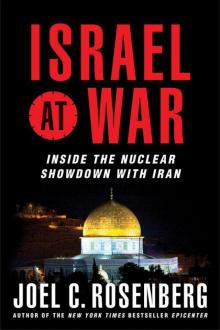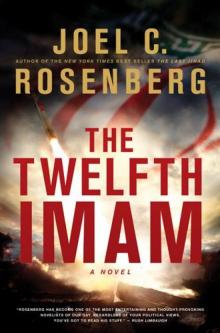- Home
- Joel C. Rosenberg
Epicenter 2.0 Page 15
Epicenter 2.0 Read online
Page 15
“What if it is already too late?” I asked. “Can you picture a scenario in which Israel is forced to take military action against Iran?”
“If it is too late and democratic change will not happen in Iran, and so much time was wasted, and the free world was too cautious to support the dissidents in Iran, then there is a very real danger that Iran will get nuclear weapons. And the free world will have no choice but to act. But I don’t want to discuss specific scenarios. Let us hope it does not go that far.”
Actually, it may have already gone that far.
WORST-CASE SCENARIOS
In February 2006, I asked Steve Forbes if he would arrange an interview for me with Caspar Weinberger, who served as U.S. defense secretary from 1981 to 1987 and was now publisher of Forbes and a foreign-affairs columnist for the world’s foremost business magazine. Steve graciously agreed and set up a time for me to call Weinberger at his home in Connecticut. It turned out to be just weeks before Weinberger passed away.
As one of the key architects of Ronald Reagan’s strategy to bring down the Evil Empire, a man who literally had his finger on the button during some of the tensest years of the American showdown with the Soviet military, few knew the Russians better than “Cap” Weinberger.174 Moreover, few had as much experience at the highest levels of the U.S. government going head-to-head against the mullahs in Iran. Weinberger, after all, had access to all U.S. intelligence about the ayatollah and the revolutionary regime in Tehran. He was there when the U.S. hostages were freed by Iran in 1981. He was there when the Reagan administration built ties to Iraq as a counterweight to Iranian aggression. He was even targeted by a grossly unfair prosecutor in the Iran-Contra arms-for-hostages affair that engulfed the second term of the Reagan administration, though he was later pardoned by President George H. W. Bush, who rightly called him a “true patriot” who gave “extraordinary service to our country.”
Weinberger, who was eighty-eight when he died, could not have been more generous with his time or more insightful with his answers. When we spoke, his memory was still sharp and his analysis still bore the distinct evidence of his decades of experience on the front lines. I asked him about a wide range of issues related to Russia and Iran, particularly if he thought Iran would go nuclear over the next few years. His answer floored me.
“I think they probably already have gone nuclear,” he told me. “I think they have probably equipped themselves to construct some types of nuclear weapons and . . . I think they could probably do quite a lot of damage right now.”175
That, Weinberger believed, was very likely why Ahmadinejad was being so provocative toward Israel—because he already possessed nuclear weapons and was preparing for a direct military confrontation.
It was a chilling theory. “If Iran has already gone nuclear,” I asked, “then why have the Russians been helping Iran build nuclear plants and providing nuclear training and technology to a country most of the world agrees is so dangerous?”
“The answer is your first clause—it’s the Russians,” Weinberger replied. “It’s the way they operate. . . . The Soviets [during the Cold War] were trying to increase their influence in the whole Mideast. They were using one of the traditional routes to the oil fields, coming through Afghanistan, and trying to seal not only their bases but their supply routes. We were taking actions and preparing ourselves to prevent that domination from succeeding. . . . [But] they have never accepted the idea that they were destined to be a second- or third-class power. They want to get their superpower status back, and that’s a lot of what Putin is doing now. . . . They [Putin and his advisors] have not really accepted the idea of democracy or a transparent form of government in which the people are able to run things. . . . They are not going to accept the fact that they were utterly and completely defeated.”
“That said, how dangerous is Vladimir Putin?” I asked.
“I think he has a suitable background for why people are worried,” Weinberger said. “He was a Soviet spy. His whole background and training was in the interest of the old Soviet policies, and I don’t think he’s changed very much. I don’t think you get far and advance as rapidly as he did unless you’re doing pretty well what you’re wanted to do [by the KGB leadership].”
Weinberger’s concerns didn’t stop with the current leader of Russia. He raised other worst-case scenarios, including someone more dangerous than Putin emerging in Moscow through election, assassination, or coup.176
In his 1996 book The Next War, Weinberger and coauthor Peter Schweizer envisioned a Russian ultranationalist seizing power in a coup in 2006 and then threatening the world with a nuclear war. I asked if he still thought this was a possibility.
“It is a possibility,” Weinberger told me, noting that while recent revolutions in ex-Soviet republics such as Ukraine, Georgia, and Kyrgyzstan have been pro-Western and pro-democracy in nature, they have only heightened fears among Russian nationalists and ultranationalists that Russia could be next if the Kremlin doesn’t crack down on dissent and rule with a heavy hand. “[Our scenario] was presented not just as a possibility but as a suitable scenario for war college and advanced strategic thinking and studying, and I think it’s still a possibility. I think you have in Russia an angry loser [and] I think it’s wrong and immature for anybody to believe that Russia has joined the Western camp. . . . We would be dangerously naive if we thought that winning the Cold War was all we had to do.”
WHAT AHMADINEJAD WANTS
The problem is that the Kremlin is playing with fire.
As I mentioned in the introduction, Iranian president Mahmoud Ahmadinejad has told friends he believes the end of the world is only a few years away. He has also said that he believes the way to hasten the arrival of the Islamic messiah is to unleash an apocalyptic holy war against Christians and Jews. Thus, he has vowed to annihilate the U.S. and Israel and is feverishly preparing his military to accomplish just that.177
The best way to understand Ahmadinejad’s brand of Shiite eschatology (end-times theology) is to listen to Iranians describe it themselves.
Amir Taheri is a European-based columnist who used to serve as the executive editor of Kayhan, Iran’s largest daily newspaper. In an April 2006 essay entitled “The Frightening Truth of Why Iran Wants a Bomb,” Taheri wrote that just before announcing to the world that Iran had “gatecrashed ‘the nuclear club,’” President Ahmadinejad “disappeared for several hours” to have a secret meeting with the Islamic messiah, a figure known as the Twelfth Imam or Mahdi. Taheri wrote, “According to Shia lore, the Imam is a messianic figure who, although in hiding, remains the true Sovereign of the World.”
The article described Ahmadinejad’s claim to be one of a select group of men specifically chosen by the Twelfth Imam to be his representatives and helpers in the world prior to his return. Ahmadinejad “boasts that the Imam gave him the presidency for a single task: provoking a ‘clash of civilizations’ in which the Muslim world, led by Iran, takes on the ‘infidel’ West, led by the United States, and defeats it.”
The article continued:
From childhood, Shia boys are told to cultivate two qualities. The first is entezar, the capacity patiently to wait for the Imam to return. The second is taajil, the actions needed to hasten the return. For the Imam’s return will coincide with an apocalyptic battle between the forces of evil and righteousness, with evil ultimately routed.178
Hossein Bastani is an Iranian journalist living in exile. He has written numerous accounts of Shiite leaders in Iran claiming to have witnessed physical sightings of the Twelfth Imam and saying that he will reveal himself to the world soon. “But despite these sightings,” Bastani noted in one column, “it is the President [Ahmadinejad] himself who presents the strongest claims of being in touch with and thus supported by the twelfth Imam.” He added that in 2005, “at a meeting with the Foreign Ministers of Islamic countries and in response to a question that Iran displayed signs of a crisis, President Ahmadinejad said that these were the signs of the return of
the twelfth Imam, who will definitely return in two years.”179
Ayatollah Ibrahim Amini is a professor at the Religious Learning Center in Qom, Iran, and one of his country’s most respected Shiite scholars. In his book Al-Imam al-Mahdi: The Just Leader of Humanity, Amini described the signs of the coming of the Mahdi in great detail. Chief among them: a massive earthquake and the launching of a global war to kill and/or subjugate Jews, Christians, and other “infidels.”
In one passage Amini quoted the prophet Mohammed (though not from the Koran), who is believed to have said, “Listen to the good news about the Mahdi! He will rise at the time when people will be faced with severe conflict and the earth will be hit by a violent quake. He will fill the earth with justice and equity as it is filled with injustice and tyranny. He will fill the hearts of his followers with devotion and will spread justice everywhere.”180
Other key passages:
When the world has become psychologically ready to accept the government of God and when general conditions have become favorable to the idea of the rulership of the truth, God will permit the Mahdi to launch his final revolution. . . . A few selected individuals . . . will be the first ones to respond to his call, and will be drawn to him like iron to a magnet in that first hour of his appearance. . . .
On seeing the fulfillment of many of the signs promised in the traditions, a large number of unbelievers will turn towards Islam. Those who persist in their disbelief and wickedness shall be killed by the soldiers of the Mahdi. The only victorious government in the entire world will be that of Islam and people will devotedly endeavor to protect it. Islam will be the religion of everyone, and will enter all the nations of the world. . . .
The Mahdi will offer the religion of Islam to the Jews and the Christians; if they accept it they will be spared, otherwise they will be killed. . . .
It seems unlikely that this catastrophe can be avoided. . . . Warfare and bloodshed [are] inevitable.181
The coming of the Twelfth Imam is never mentioned in the Koran. Rather it stems from supposed sayings of Mohammed and his followers soon after the Koran was complete. Thus, not all Muslims share the brand of theology I have just outlined, nor do all Shiites.182 But Ahmadinejad and his close aides and advisors leave no doubt that they are driven by the belief that the Islamic messiah will appear in the next two or three years and that by launching a war to annihilate Israel, in particular, they can hasten that day.
CHAPTER NINE: FUTURE HEADLINE
MOSCOW EXTENDS MILITARY ALLIANCE TO INCLUDE ARAB, ISLAMIC WORLD
In his classic treatise The Art of War, the ancient Chinese strategist Sun Tzu wrote, “What enables the wise sovereign and the good general to strike and conquer, and achieve things beyond the reach of ordinary men, is foreknowledge. [T]his foreknowledge cannot be elicited from spirits; it cannot be obtained inductively from experience, nor by any deductive calculation. Knowledge of the enemy’s dispositions can only be obtained from other men. Hence the use of spies.”183
It should not be surprising, then, that a man like Saddam Hussein was determined to know as much as he possibly could about the enemies arrayed against him in the days leading up to the commencement of Operation Iraqi Freedom on March 19, 2003. What may be surprising to some is the role that Vladimir Putin and Russian intelligence played in tipping off Saddam to the precise composition and location of American fighter aircraft, helicopters, naval ships, cruise missiles, tanks, armored vehicles, artillery, and even the location and number of special-forces units.
Top secret Iraqi documents captured by the U.S. military during the invasion of Baghdad and recently released to the public by the Pentagon reveal an intriguing look inside Saddam’s war room and the startling degree of cooperation between Putin and Hussein, despite Putin’s well-publicized friendship with President Bush and their supposed partnership in the War on Terror. One handwritten document is a memo written to Saddam and his top advisors, describing a meeting with Russia’s ambassador to Iraq about two weeks before the outbreak of hostilities.
Captured Iraqi Document CMPC-2003-001950
[Handwritten, undated, but written before March 5, 2003]184
To: Office of the President, Mr. Secretary
Re: Meeting with the Russian Ambassador
Our warmest greetings!
We would like to inform you that the Russian ambassador met this evening with [Iraqi officials] and he informed us of . . . the departure of Russian specialists working on projects belonging to our ministry without delay for the period March 5-8, with the last plane departing on March 9, as he conveyed. He explained that the request for the evacuation of Russian citizens came at the order of the Russian president. . . . During this meeting the ambassador presented the following information about the American military presence in the Gulf and the region as of March 2:
- Number of forces: 206,500, including 98,000 marines and 36,500 infantry. Ninety percent of these forces are in Kuwait and on American military vessels.
- American forces have also reached Bubiyan Island.
- Number of tanks: 480
- Number of armored vehicles: 1,132
- Number of artillery pieces: 296
- Helicopters (Apache): 735
- Fighter planes: 871
- Units of the American fleet: 106, including 68 in the Gulf and the remainder in Oman, Aden, the Red Sea, and the Mediterranean
- Number of aircraft carriers: 5, including one nuclear-powered [carrier]; three of them are in the Gulf, one in the Mediterranean, and the other in [unclear, ed.]
- Number of cruise missiles: 583, belonging to the American navy, distributed among 22 naval vessels
- Number of aircraft-borne cruise missiles: 64
- Number of heavy planes (B-52H) in the Indian Ocean: 10
- Number of B-1B at the American base in Oman (Thumrait): 8
The ambassador indicated that what concerns us is the increase in the number of planes in Jordan. He explained that the number of these planes at Al-Salt Base is now as follows:
- 24 F-16s
- 10 Tornadoes
- 11 Carriers [F-18s]
He also indicated that there are five A-10 tank killers at the King Faisal Base in Jordan. The ambassador also indicated that a number of individuals from the 82nd [Airborne] Division have begun arriving [in] Kuwait. This division was located in Afghanistan, and the number of individuals who have arrived is 750.
Captured Iraqi documents reveal that even after the war began, Russian intelligence continued to provide Saddam Hussein and his top advisors updated information on U.S. and coalition forces and plans, as well as the highly sensitive movements of the U.S. 4th Mechanized Infantry Division and elite Delta Force.185
Fortunately, Saddam was not able to use such intelligence to defeat the U.S. or coalition forces. What’s more, some of the Russian intelligence turned out to be flat-out wrong.
Still, such documents are valuable for several reasons. They give us a sense of the extent to which Moscow will go to support one of its client states in the Middle East, no matter how evil that client state’s regime is. They give us a sense of how determined the Kremlin is to be a player in the Middle East and to counter U.S. and Western involvement there. What’s more, they underscore the insight of Sun Tzu that foreknowledge of the enemy’s plans, allies, and dispositions is critical in all warfare, both ancient and modern.
EZEKIEL’S FOREKNOWLEDGE
This brings us back to Ezekiel and the foreknowledge he reveals.
While Iran is the first country identified as a future ally of Russia, there are others, and it is important that we identify them before we look to see if Russia is building military partnerships with such countries today.
In Ezekiel 38:2-6 we find such cryptic-sounding countries as Cush, Put, Gomer, and Beth-togarmah. Let’s decode these names one by one.
Cush
The first biblical mention of the people of Cush is in Genesis 10:6, which reads, “The sons of Ham were Cush and Mizra
im and Put and Canaan” (NASB). Sons of Cush settled in Arabia, Mesopotamia, and Assyria (Genesis 10:6-11). But the Scriptures identify the Cushites themselves as geographically centered in Africa. Several major English translations of the Bible, for example, translate Cush as “Ethiopia.”186 The ancient historian Josephus also traced the Cushites (he called them Chusites) to the land of Ethiopia.187 But the land once known as ancient Ethiopia encompassed far more territory than does the country we know today by that name. It included the modern-day country of Sudan and possibly modern-day Eritrea as well.188
Put
Josephus wrote that “Phut . . . was the founder of Libya, and called the inhabitants Phutites.”189 But, again, ancient Libya actually encompassed more territory than does the country we know by that name today. Thus, it is reasonable to believe that Ezekiel’s Put also included the modern-day countries of Algeria and Tunisia, though it may not have extended as far as Morocco.190
Gomer
There is no clear historical consensus on the present-day location of Gomer “and all its troops” or “all its bands” or “all its hordes,” though the dominant theories are modern-day Turkey and/or modern-day Germany. We do know from Genesis 10 that Gomer—like Magog, Meshech, and Tubal—was a son of Japheth, which puts them all into one big, violent clan. From there it gets a bit murky.
Josephus, for example, wrote that “Gomer founded those whom the Greeks now call Galatians, but were then called Gomerites.”191 The Galatians of the New Testament lived in the region of Turkey to which the apostle Paul wrote the book of Galatians and from which the Ottoman Empire emerged to take over much of the Middle East.
The question is whether the Gomerites drifted from what we now call Turkey to other countries over the centuries. Voltaire wrote that “it is incontestable that the inhabitants of Gaul [France] and Spain are descended from Gomer.”192 Other sources say the Gomerites and their relatives migrated northward to Germany. Genesis 10:3 identifies one of Gomer’s relatives as Ashkenaz. Today, Israelis describe Jews from Germany, Austria, and Poland as “Ashkenazim.”

 The Copper Scroll
The Copper Scroll The Auschwitz Escape
The Auschwitz Escape The Last Jihad
The Last Jihad Damascus Countdown
Damascus Countdown The Persian Gamble
The Persian Gamble The Jerusalem Assassin
The Jerusalem Assassin Dead Heat
Dead Heat Israel at War: Inside the Nuclear Showdown With Iran
Israel at War: Inside the Nuclear Showdown With Iran The Last Days
The Last Days The Twelfth Imam
The Twelfth Imam Epicenter 2.0
Epicenter 2.0 The Kremlin Conspiracy
The Kremlin Conspiracy Implosion: Can America Recover From Its Economic and Spiritual Challenges in Time?
Implosion: Can America Recover From Its Economic and Spiritual Challenges in Time? The Third Target: A J. B. Collins Novel
The Third Target: A J. B. Collins Novel The Tehran Initiative
The Tehran Initiative Inside the Revolution
Inside the Revolution Implosion
Implosion The First Hostage: A J. B. Collins Novel
The First Hostage: A J. B. Collins Novel